Top trail pants to keep you warm, dry and clean in the slop
Whether water’s falling from the sky or splashing up from the trail, waterproof mountain biking trousers can make a huge difference to how much you enjoy wet-weather riding.
Keeping dry means you can spend longer on the trails, makes the post-ride clean-up operation much easier, and also helps you avoid the dreaded soggy chamois.
Waterproof mountain biking trousers are generally not cheap, so you’ll need to seek out waterproof and breathable materials that stand up to abuse on the trails to make sure your investment is worthwhile. However, there are bargains to be had, too, and you’ll appreciate the investment next time you’re cycling in the rain.
These are the best waterproof mountain bike trousers tested in our recent winter group test.
Not sure what you’re looking for? Check out our full buyer’s guide at the bottom of this article.
Best waterproof MTB trousers
Decathlon Rockrider All-Mountain
- Material: 88% polyester, 12% elastane with DWR treatment
- Sizes: S, M, L, XL, XXL, XXXL
- Weight: 307g (M)
- Price: £40 as tested
For the money, the Decathlon Rockrider All-Mountain trousers are amazing. Even though Decathlon claims they are just water-resistant, not fully waterproof, the triple-layer seat and calf panels only started to soak through after long wet-weather rides.
The thighs and waist are made from a stretchy, breathable fabric, with a DWR coating and ample room for knee pads. This treatment does a good job of making water bead and run off, and even once the material wetted through, the trousers remained comfy and didn’t stick to our legs. The waist is secure enough to stop them slipping down, too.
A raised rear prevents mud splashing onto your back, while elastic ankle cuffs keep water from splashing up inside. The stretchy, lightweight material feels snug and dries fairly quickly.
Watch out – sizing is on the small side, especially around the waist and crotch, so consider going up. The two zipped pockets also aren’t big enough to comfortably store a smartphone.
Fox Defend 3-Layer Water Pants
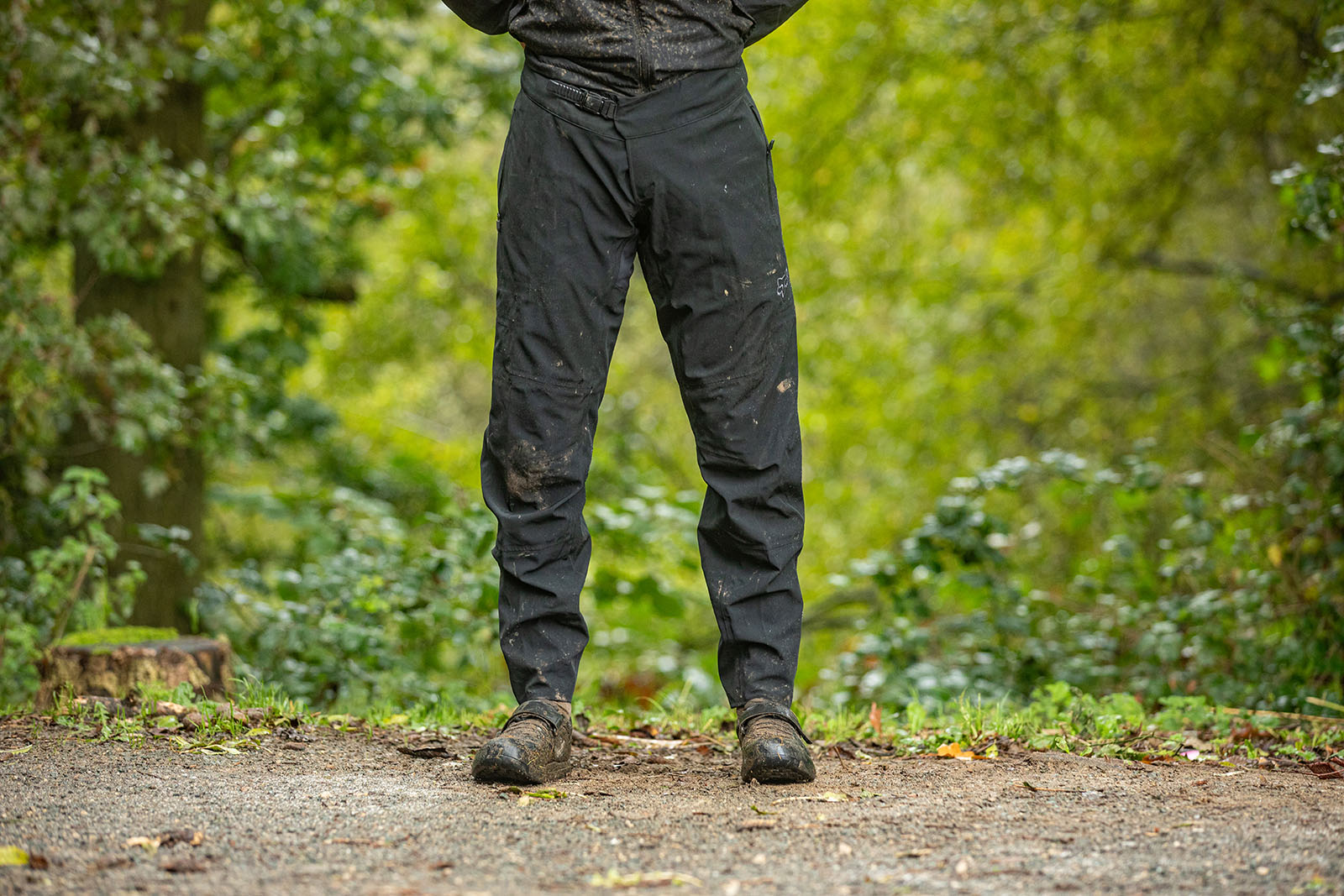
- Material: 3-Layer polyester/nylon with Cordura panels
- Sizes: 28, 30, 32, 34, 36, 38in
- Weight: 434g (34in)
- Price: £189.99 / $250 / €190 as tested
Fox’s Defend 3L Water Pants use a heavy-duty 3-layer construction, with the outer featuring a DWR coating to cause water beading.
While it has a low waistband with no silicone grips to keep the trousers in place, we found the Defend Water Pants to remain stable even when caked in mud.
Breathability is good too, with our tester finding the trousers to maintain a good temperature, avoiding condensation on the inside.
Fox Ranger 3L Water Pants
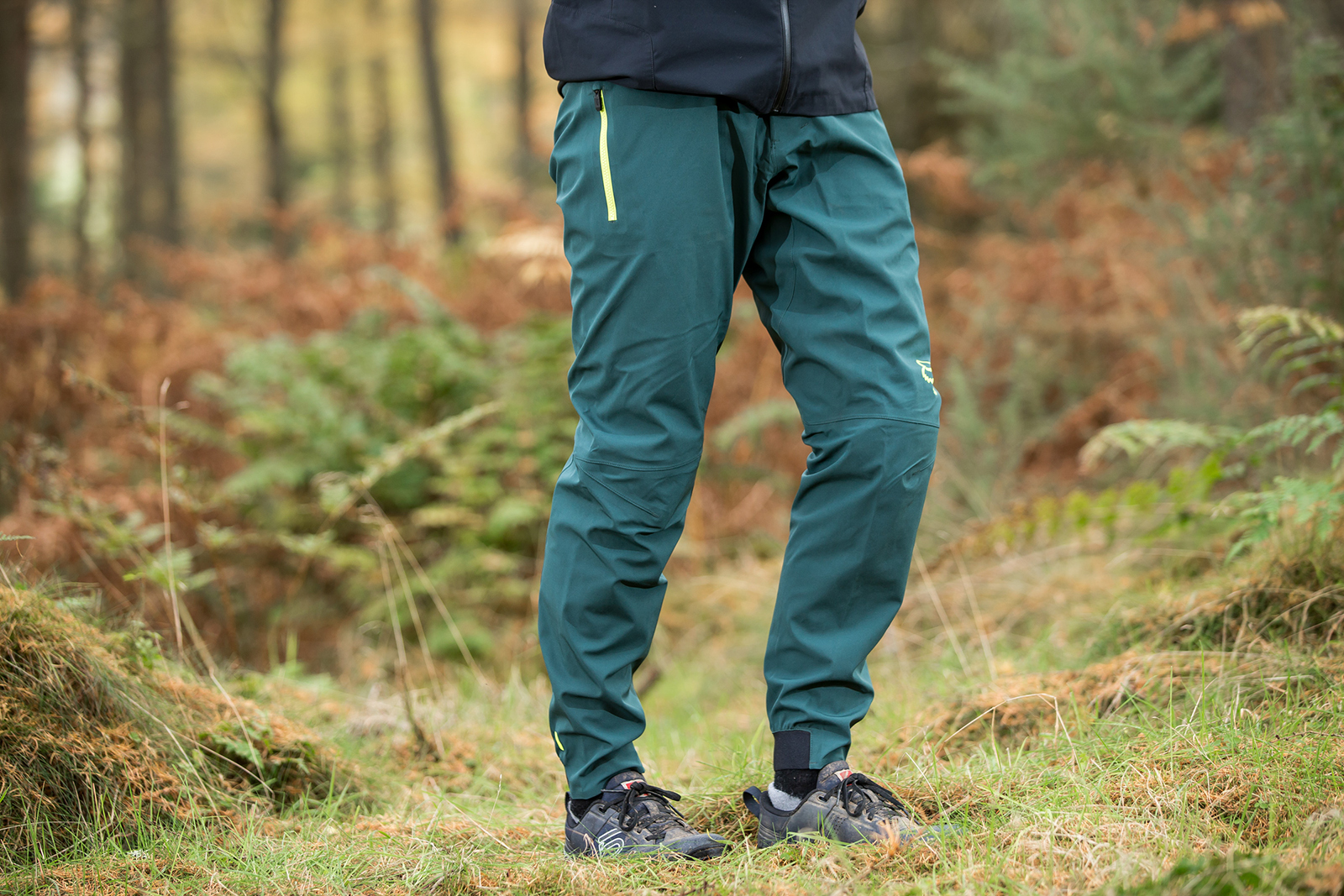
- Material: Three-layer, 94% polyester, 6% elastane with DWR treatment
- Sizes: 28, 30, 32, 34, 36, 38, 40in
- Weight: 330g (30in)
- Price: £140 / $175 / €150 as tested
In the correct size, the fit of these Fox Ranger 3L Water Pants is perfect and sculpts to the riding position well.
There’s ample space for knee pads, and tapering at the calves means they don’t flap in the wind. Elastic ankle cuffs prevent water splashing upwards and the legs from riding up.
A ratchet strap provides reliable and secure waist adjustment and prevents the trousers from falling down once wet. They didn’t soak through during testing, keeping us totally dry after hours of torturous wet-weather riding, even once they were covered in mud.
The material feels soft and doesn’t stick to the skin, even when sweaty.
There are two zipped pockets, which are large enough for essentials; a smartphone is a squeeze and causes a bit of bunching, but doesn’t make the pants uncomfortable to wear.
As for sizing, try before you buy, because the waist sizes up quite large and adjustment is limited.
In contrast, the legs are quite short, so we ended up pairing these trousers with waterproof socks. They get quite hot on climbs, too.
POC Consort MTB Dungaree

- Material: Cordura
- Sizes: XS, S, M, L, XL, XXL
- Weight: 409g (medium)
- Price: £450 / €490 / $500 as tested
If you can’t put a price on staying warm and dry, the phenomenally expensive POC Consort MTB Dungaree could be the waterproof mountain bike solution for you.
The Consort MTB Dungaree withstands filthy and soaking conditions, while proving breathable when your temperature rises – well-placed vents also help keep you cool.
The dungarees fit fantastically and are comfortable on and off the bike.
There are zipped pockets to stash valuables, such as your mobile phone, too.
Rab Cinder Kinetic

- Material: 3-layer Proflex fabric
- Sizes: XS, S, M, L, XL (both regular and long lengths)
- Weight: 314g (L)
- Price: £210 / $240 / €250 as tested
Rab hasn’t spent long making mountain bike clothing, but its legacy in outdoor clothing has carried over well, with the Cinder Kinetic trousers featuring the brands Proflex material.
The trousers fend water off well, with a mixture of waterproof panels adding different levels of protecting and robustness to certain parts.
With a great fit and finish, the Cinder Kinetic trousers offer exceptional functionality for mountain biking, although enduro riders and DH riders may want something with more crash protection.
7mesh Grit Pants
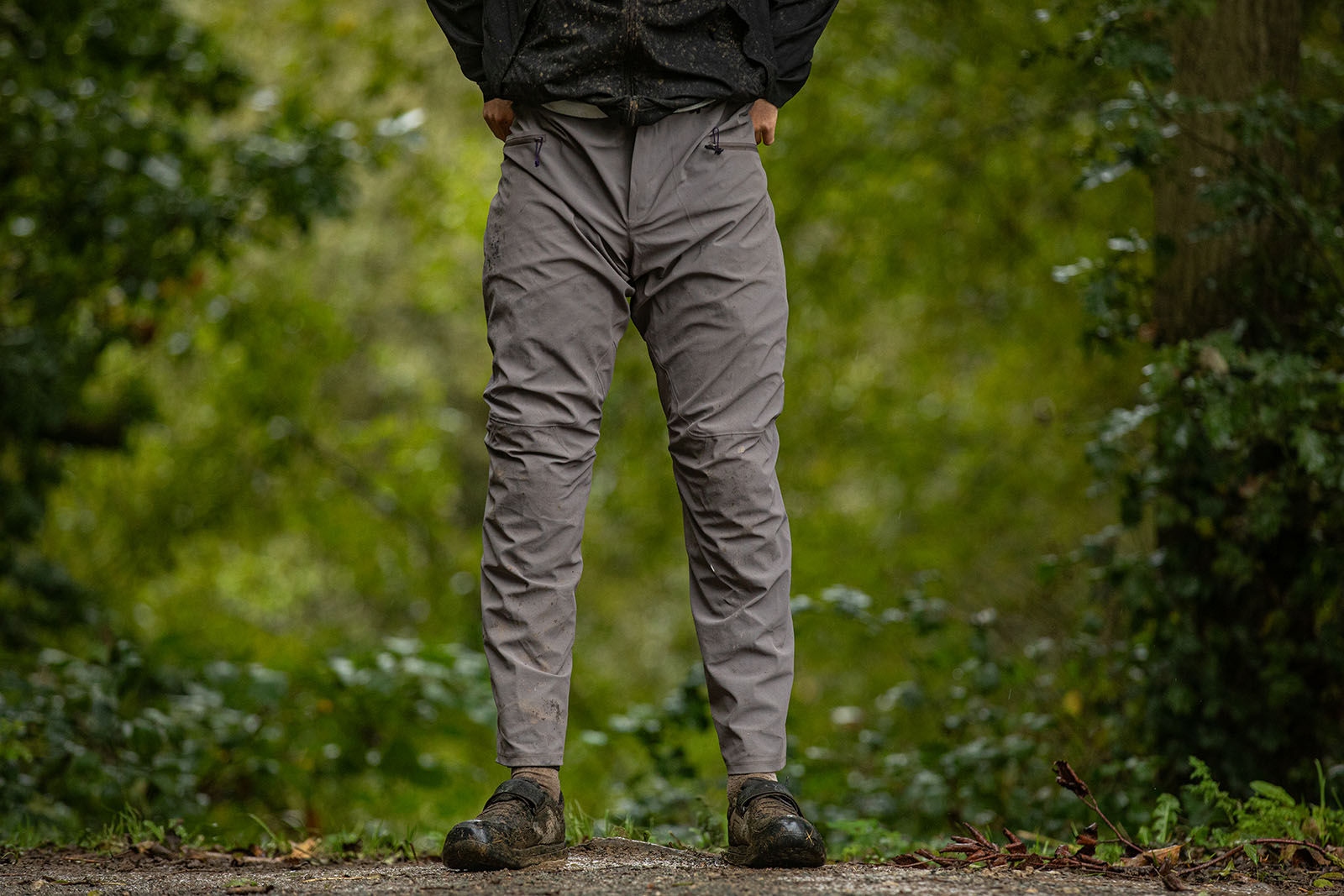
- Material: Polyester
- Sizes: XS, S, M, L, XL, XXL
- Weight: 325g (L)
- Price: £280 / $300 / €300 as tested
7mesh’s Grit Pants offer high levels of breathability at the sacrifice of full waterproofing, with the trousers quick to saturate on the thigh panels.
With heavy rain not in the design brief, the Grit Pants handle light showers well and are very quick to dry should your fortunes change mid-ride.
The trousers are good for cold-weather rides, with the fit, adjusters and fasteners combining to make an excellently finished product – albeit a pricey one.
7mesh Thunder Pant
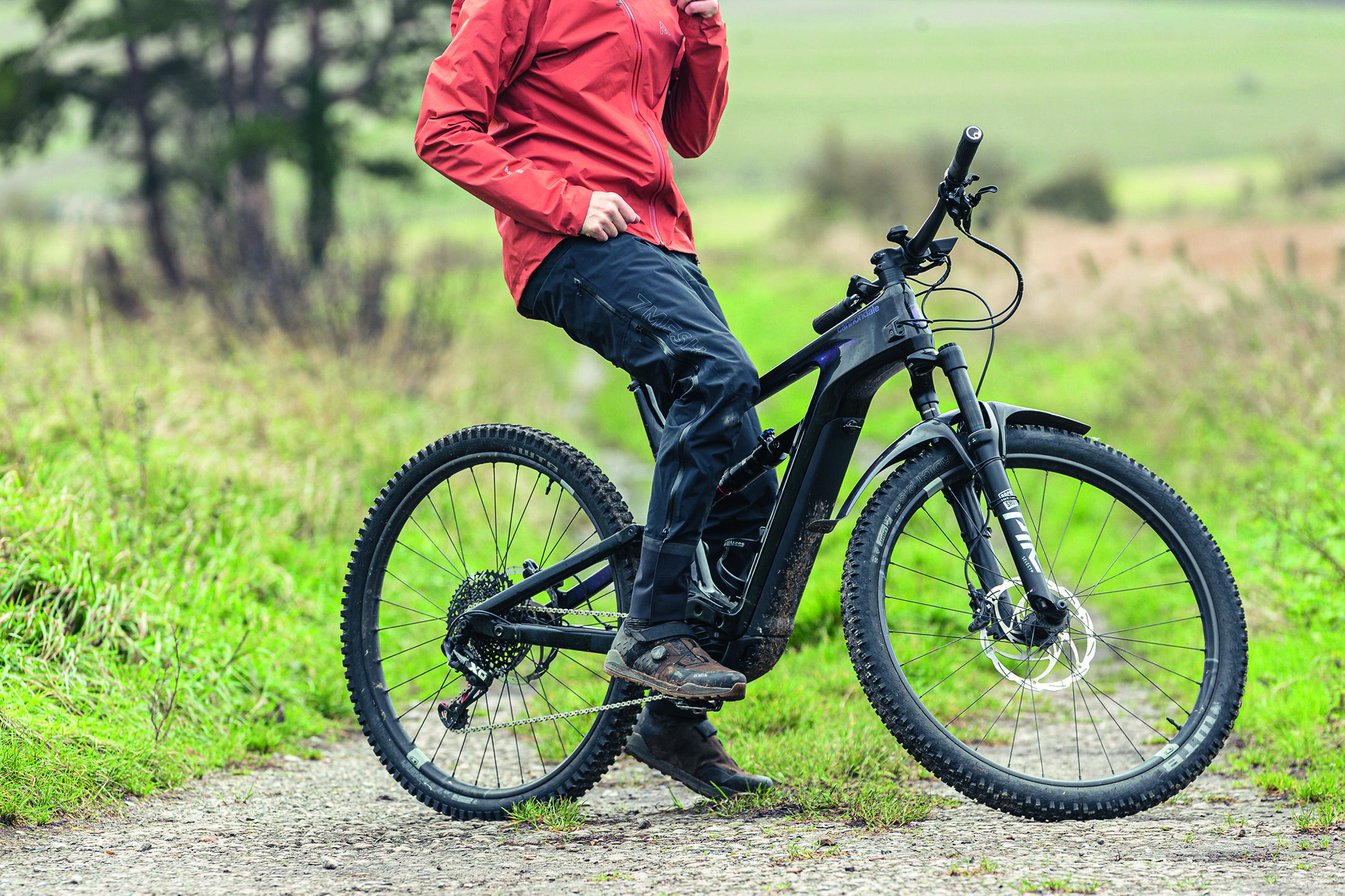
- Material: Gore-Tex
- Sizes: XS, S, M, L, XL, XXL
- Weight: 300g
- Price: £300 / €350 / $350 as tested
The 7mesh Thunder Pant trousers are expensive, but they’re among the best waterproof mountain bike riding pants you can buy.
These 7mesh trousers are made from completely waterproof and highly breathable Gore-Tex Pro material.
Long waterproof leg zips enable you to pull the trousers on easily over shoes. The double zips open from the top if you need ventilation.
The cut is perfect, with no drag at the knee when riding, and the back sits comfortably high.
Endura SingleTrack Waterproof One-Piece

- Material: Polyester
- Sizes: S, M, L, XL, XXL
- Weight: Not specified
- Price: £199.99 as tested
Mountain bike onesies work well in the rain and the Endura SingleTrack Waterproof One-Piece is among the best around.
The SingleTrack looks as though you’re wearing a waterproof jacket and trousers, and it performs in the same vein.
You can pull down the front zip and long underarm zips for ventilation when climbing. The lack of gap at the rear stops blasts of icy water shooting up your back.
The ExoShell20 fabric is sufficiently waterproof and breathable to keep you dry, except in deluges and sweaty climbs.
Side pockets can hold a phone and the hood tips over a helmet.
Fit is iffy across the shoulders and waist, but the arms and legs are tailored better.
Troy Lee Designs Resist
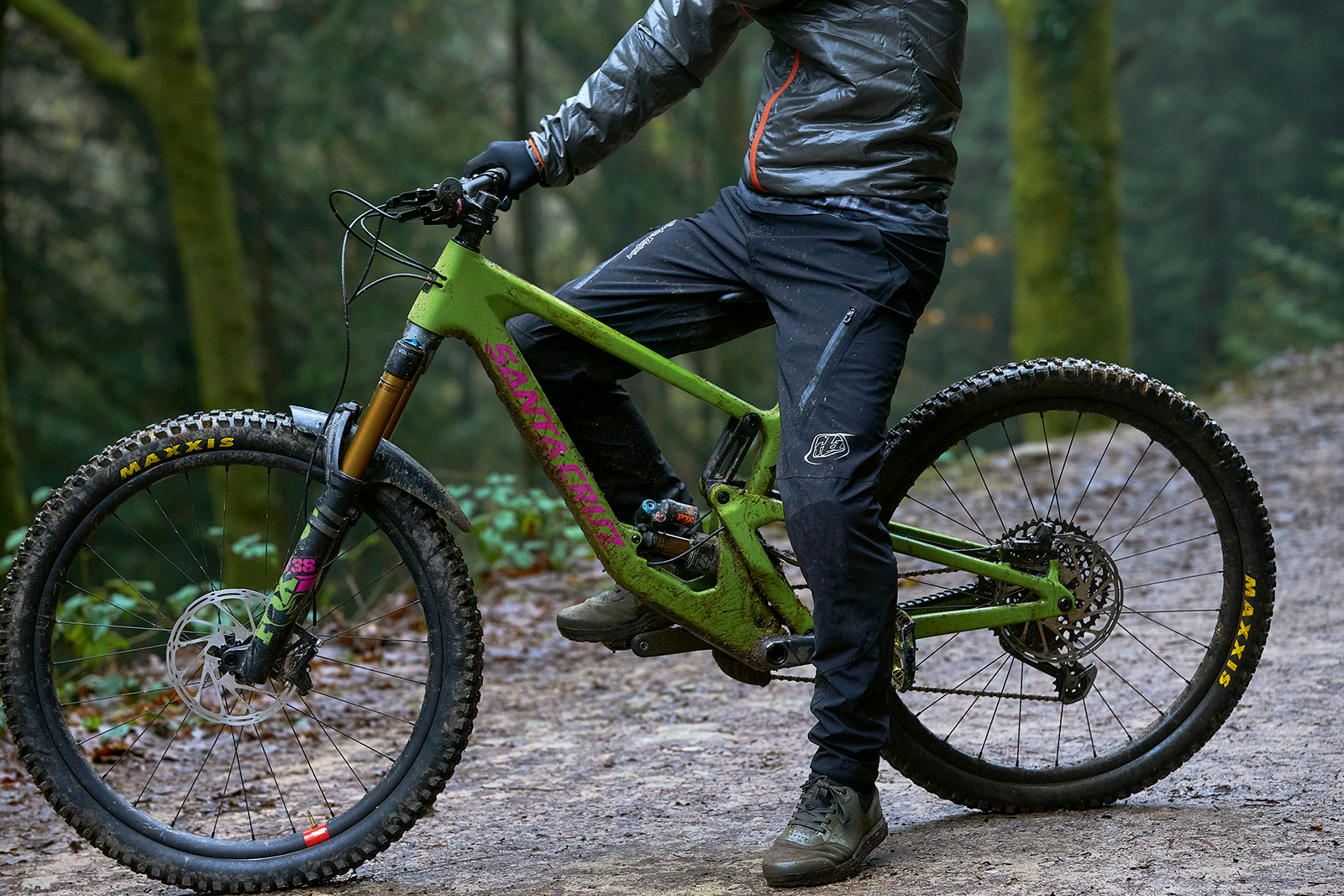
- Material: Bluesign-certified 10k/10k waterproof stretch fabric
- Sizes: 30, 32, 34, 36, 38, 40in
- Weight: Not specified
- Price: £149 / $149 as tested
The Troy Lee Designs Resist trousers are made of a stretchy, eco-friendly fabric that’s very breathable and copes well with rain, with taped seams to keep out water.
They’re not rustly and the fabric is a little warmer than some on cold rides, while zipped thigh vents help on warmer rides.
There are three zipped pockets and waist adjustment to ensure a good fit, while the high waistband and reinforced seat ensure you don’t get wet from wheel spray.
The legs taper nicely, so they don’t flap around even when wet or muddy, but still leave enough room to wear knee pads underneath.
Although they coped with most conditions, the Resists did wet out at the front of the legs in prolonged downpours, but this never left us feeling cold at the end of a ride.
Also consider…
The following trousers scored fewer than 4 out of 5 in our reviews but are still worth considering.
Gore C5 Gore-Tex Paclite
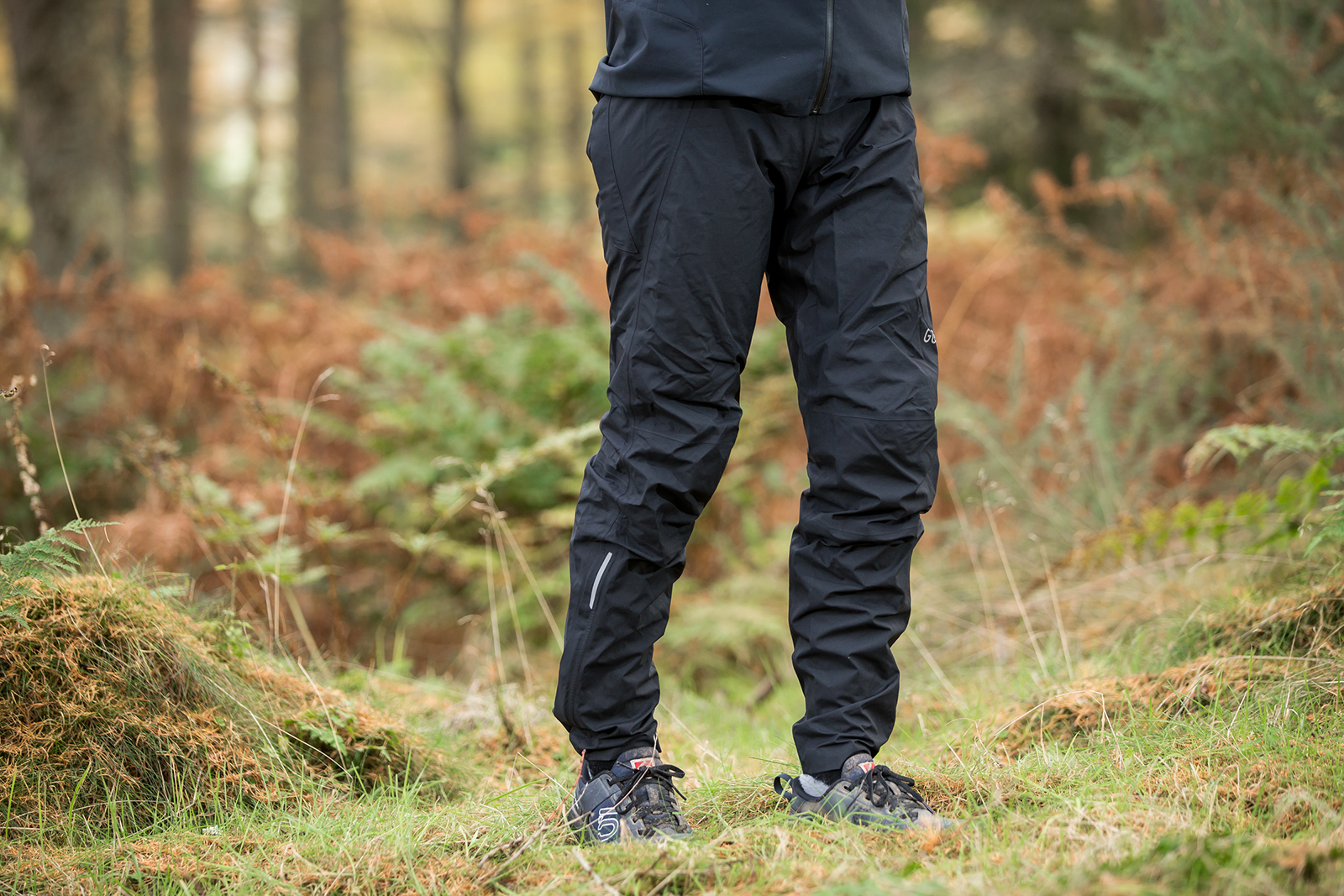
- Material: Gore-Tex Paclite Plus 100% polyamide
- Sizes: S, M, L, XL, XXL
- Weight: 167g (M)
- Price: £180 / $200 / €200 / AU$265 as tested
True to Gore’s claims, the C5 Paclite trousers kept us dry during testing and didn’t wet through or leak during the post-ride hose-down.
There’s a raised panel at the rear, which helps reduce the amount of water and mud splashing onto the small of your back. At the waist, a drawcord, fastened with a knot, prevents them falling down once wet.
They fit true to size and, while there isn’t much stretch in the fabric, there was no excess tension around the crotch or hips. The large, calf-height zip makes it easy to take them off with shoes on. They’re light too, at 167g for our medium pair.
However, the lack of thigh vents means these trousers get quite hot and, once we got sweaty, our legs stuck to the inside. We found they tugged knee pads down, especially when pedalling seated.
The ankle cuff poppers aren’t as good as an elasticated cuff and don’t feel very refined, considering the high price. We struggled to fit a modern smartphone in the single pocket.
Alpkit Parallax
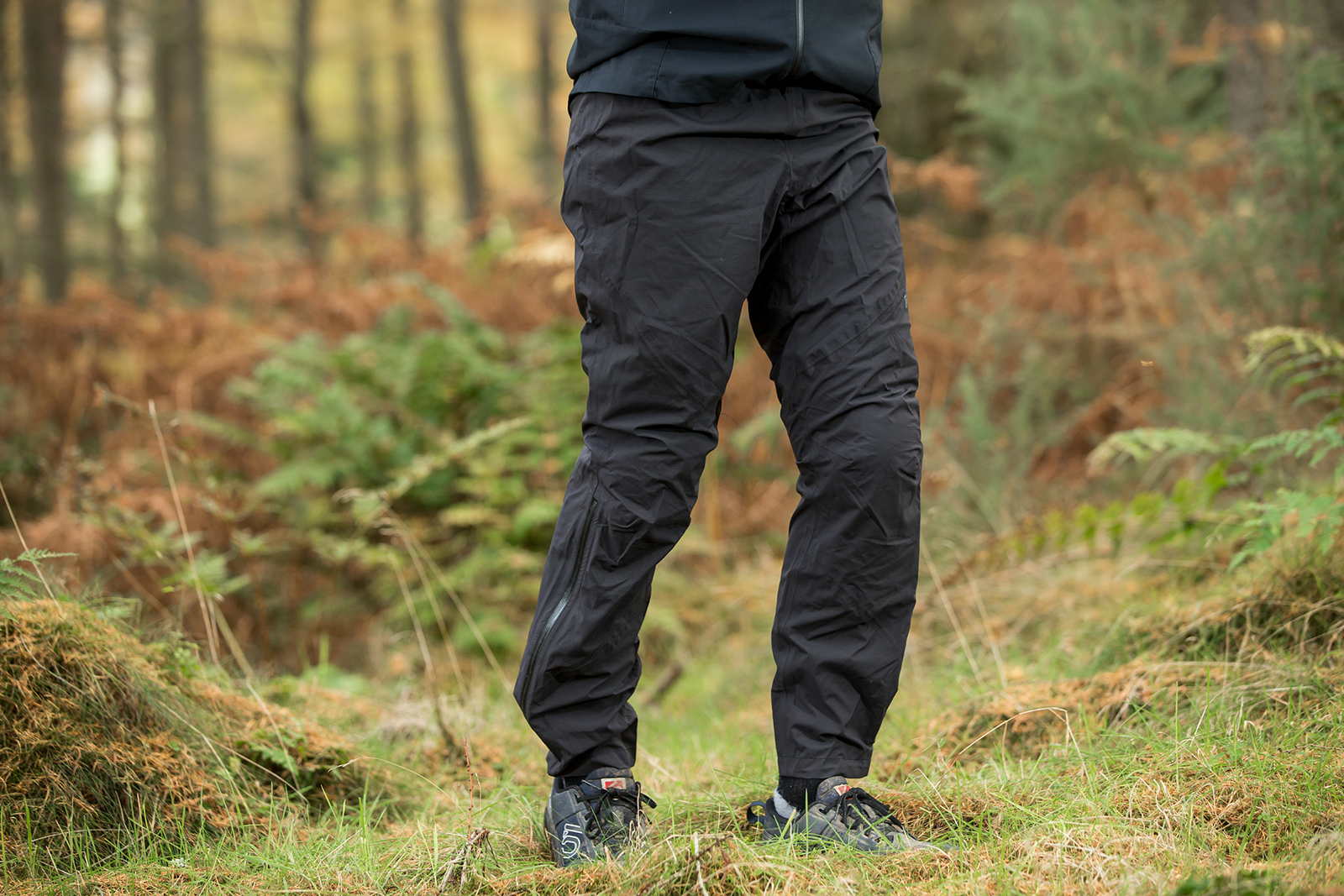
- Material: 2.5-layer, 100% nylon with PU membrane
- Sizes: S, M, L, XL
- Weight: 182g (S)
- Price: £80 / $100 / €90 / AU$147 as tested
The Alpkit Parallax trousers deal with sweat well, the inside only getting wet on very slow climbs. Once damp (we’ll come on to waterproof performance), they were still comfortable against our skin and didn’t cause knee pads to fall down.
We like the light feel and the way they pack easily into the supplied bag. The elasticated waist and adjustable pull-cord meant we could tighten the pants so they didn’t fall down, even when covered in mud and water.
On the flipside, the fit is fairly baggy, especially around the calves, where the material flaps in the wind. Adjusting the Velcro ankle cuffs doesn’t reduce the volume either.
While the trousers resisted full water penetration during testing, the 2.5-layer material did wet out quickly, with the outer layer getting soaked through and making the trousers feel damp on the inside, even though the water didn’t get all the way in.
This suggests the DWR coating can’t cope with the abrasion and rubbing of bike use. When we hosed them down at the end of a ride, the seams leaked, letting water in.
These are also available in a women’s cut.
Buyer’s guide: what to look for when buying waterproof MTB trousers
Waterproofing
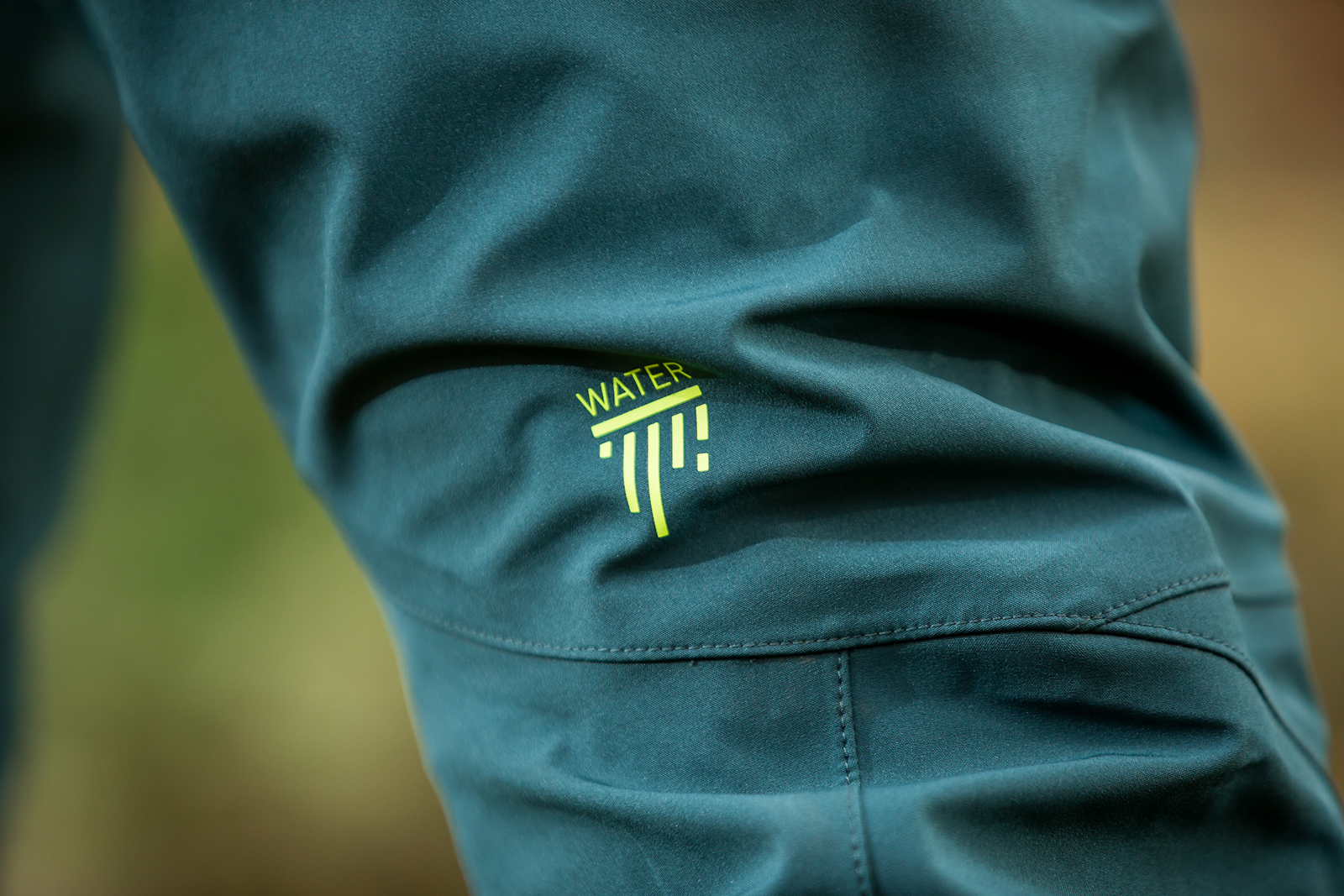
Waterproof materials are typically made up of two or three layers, including a waterproof membrane, often backed by a softer material against your skin and sandwiched between a tougher external layer (or ‘face fabric’).
A fabric’s waterproof rating will demonstrate whether it’s able to stand up to drizzle or heavy downpours, and is measured by a material’s resistance to water before it leaks through, conducted under lab conditions.
The higher the number, the more resistant to water ingress and bad weather conditions the material will be, with ratings of 16,000mm and over suitable for wet conditions, and 20,000mm and above among the best.
Seams are an obvious weak point in any waterproof fabric, so they are often sealed and taped internally to try to stop water getting in.
DWR (Durable Water Repellent) treatment is often used on the external surface of the fabric to help precipitation or trail spray bead off the surface.
As this treatment degrades over time with laundry cycles, it can be reapplied to the fabric using reproofing sprays or washes. Look out for PFC-free DWR treatments for the most environmentally friendly solution.
Construction
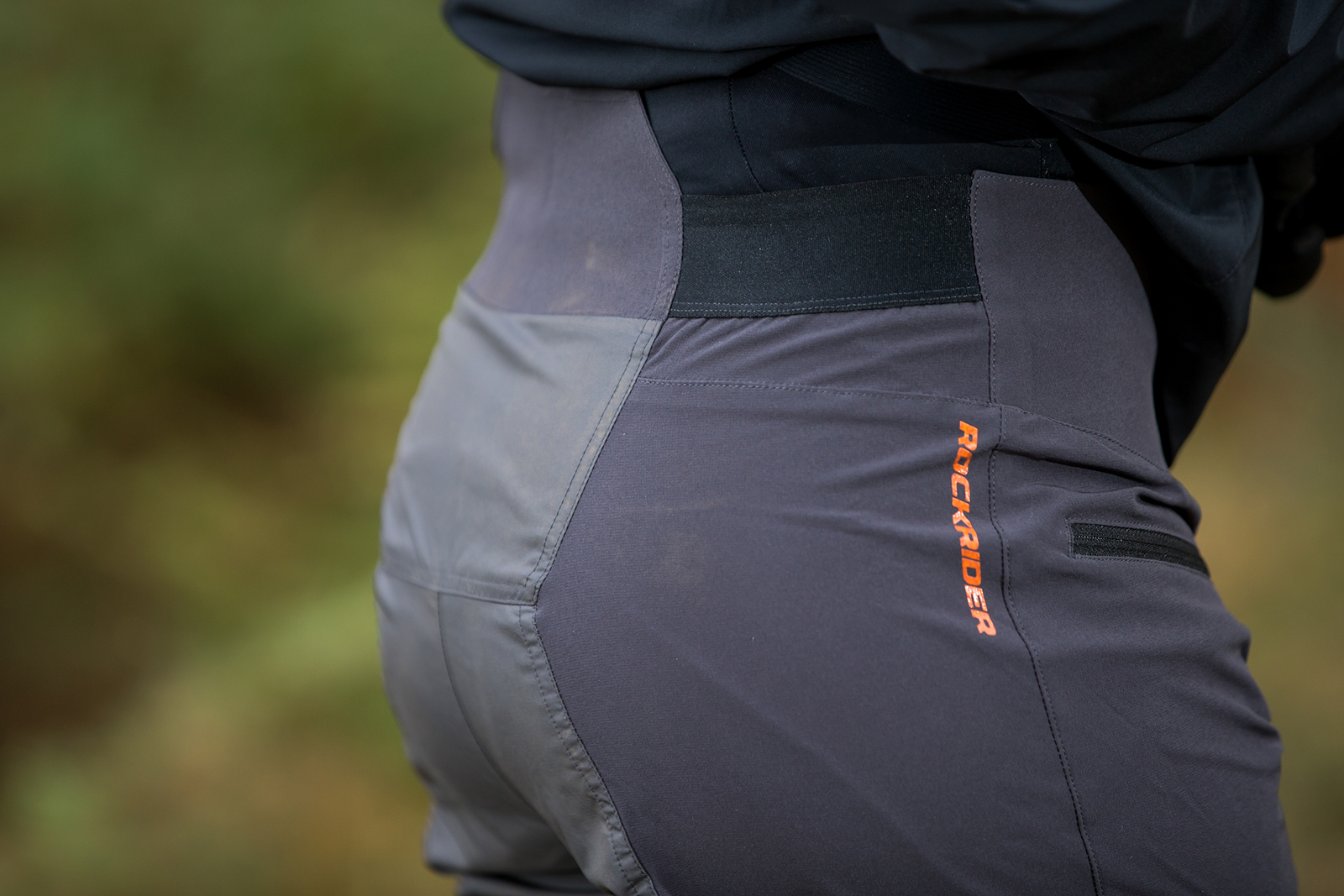
Mountain biking trousers aren’t often made completely from waterproof materials, but instead use a combination of strategically placed panels of waterproof, water-resistant and breathable fabrics to give the best overall performance.
The areas that typically get wettest include the seat and backs of the legs, from spray off the back wheel, so these usually feature the most robust waterproof materials and taped seams.
Some trousers will feature areas of DWR-treated water-resistant fabrics, such as on the front of the thighs, because these are less likely to get as wet. The idea here is to provide some protection from rain or trail spray, though the fabric isn’t necessarily fully waterproof.
Breathability and ventilation
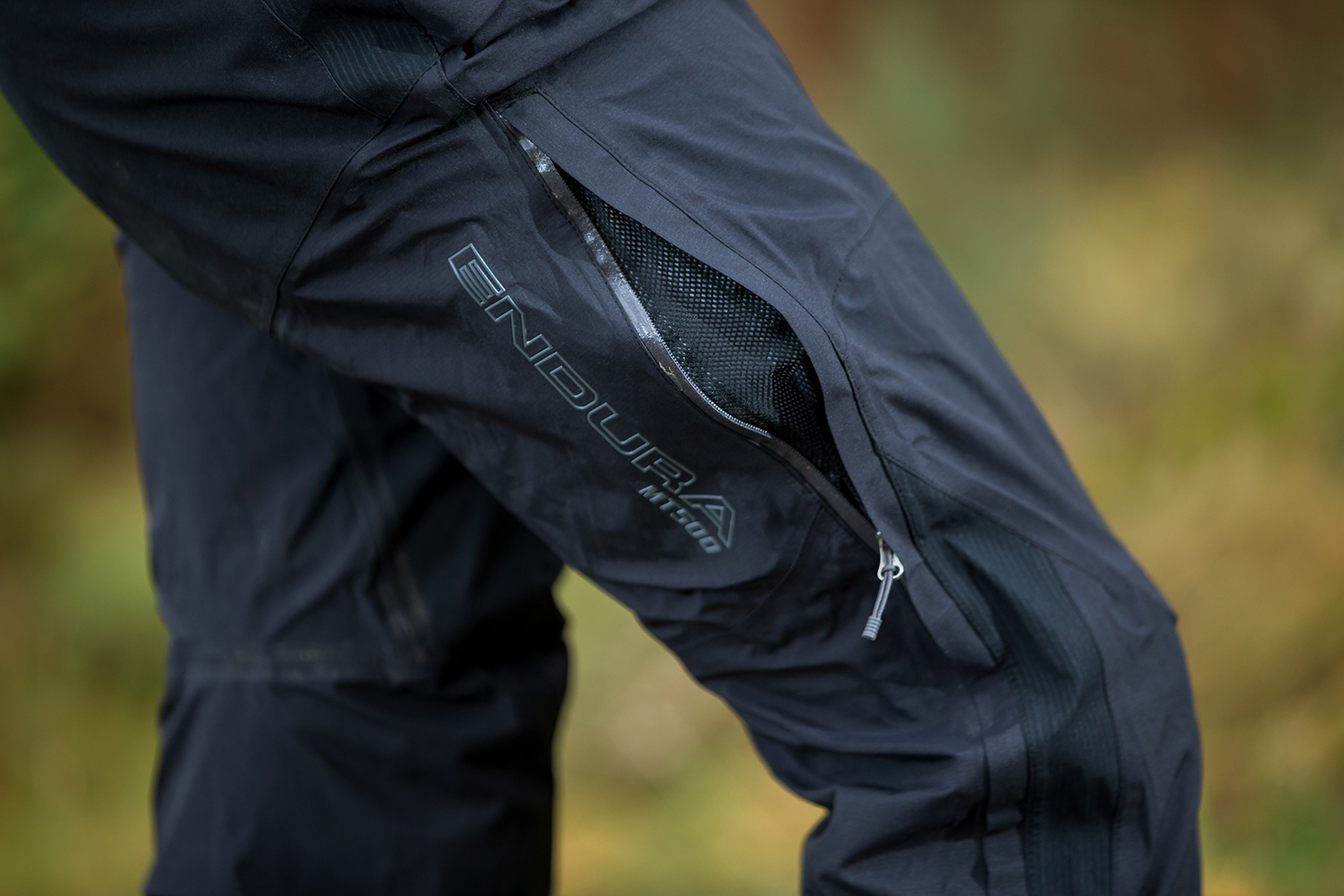
The flipside of waterproofing is breathability, as anyone who’s sweated buckets inside cheap waterproofs (whether that’s a jacket or trousers) will be all too aware.
Maintaining airflow, ventilation and sweat evaporation while keeping water out is the holy grail for any waterproof product and can be achieved by using high-tech breathable fabrics and strategically placed vents.
Some trousers have zipped vents to help maintain airflow when it’s not bucketing it down or when riding uphill, typically found on the upper thighs.
The Water Vapour Transmission rating (WVTR) measures how breathable materials are, by testing how much water vapour can travel through the material in given conditions. The higher the rating, the more effective it will be at keeping you comfortable during higher-intensity riding.
Look for ratings of 20,000g/m²/24hr and above for good breathability.
Fit and cut

Waterproof riding trousers should fit similarly to conventional MTB trousers, with a tapered lower leg to reduce the risk of getting the fabric caught in the drivetrain or flapping, and an adjustable waistband to tailor the fit. A higher cut at the back also gives extra splash protection.
Ideally, you’ll want a snug but non-restrictive fit: too loose and you could risk the trousers sagging; too tight and they’ll be uncomfortable or restrictive. Look out for elastane blend materials to help give extra stretch, and make sure there’s plenty of room for you to wear knee pads underneath too.
Some waterproof trousers are designed to be worn over your normal riding trousers, with full-length zips for ease of getting on and off, and a slightly looser fit so you can layer up underneath.
Pockets

Pockets with a waterproof lining and waterproof zip are best for storing valuables.
These should be located away from the hip area, such as on the outer thigh, so they don’t interfere with leg movement when pedalling.
Other features

Besides countering the elements, waterproof trousers must also be robust enough to endure the rigours of mountain biking, so look out for additional features, including abrasion-resistant panels.
If you’re planning on mountain biking at night, reflective details are another bonus.